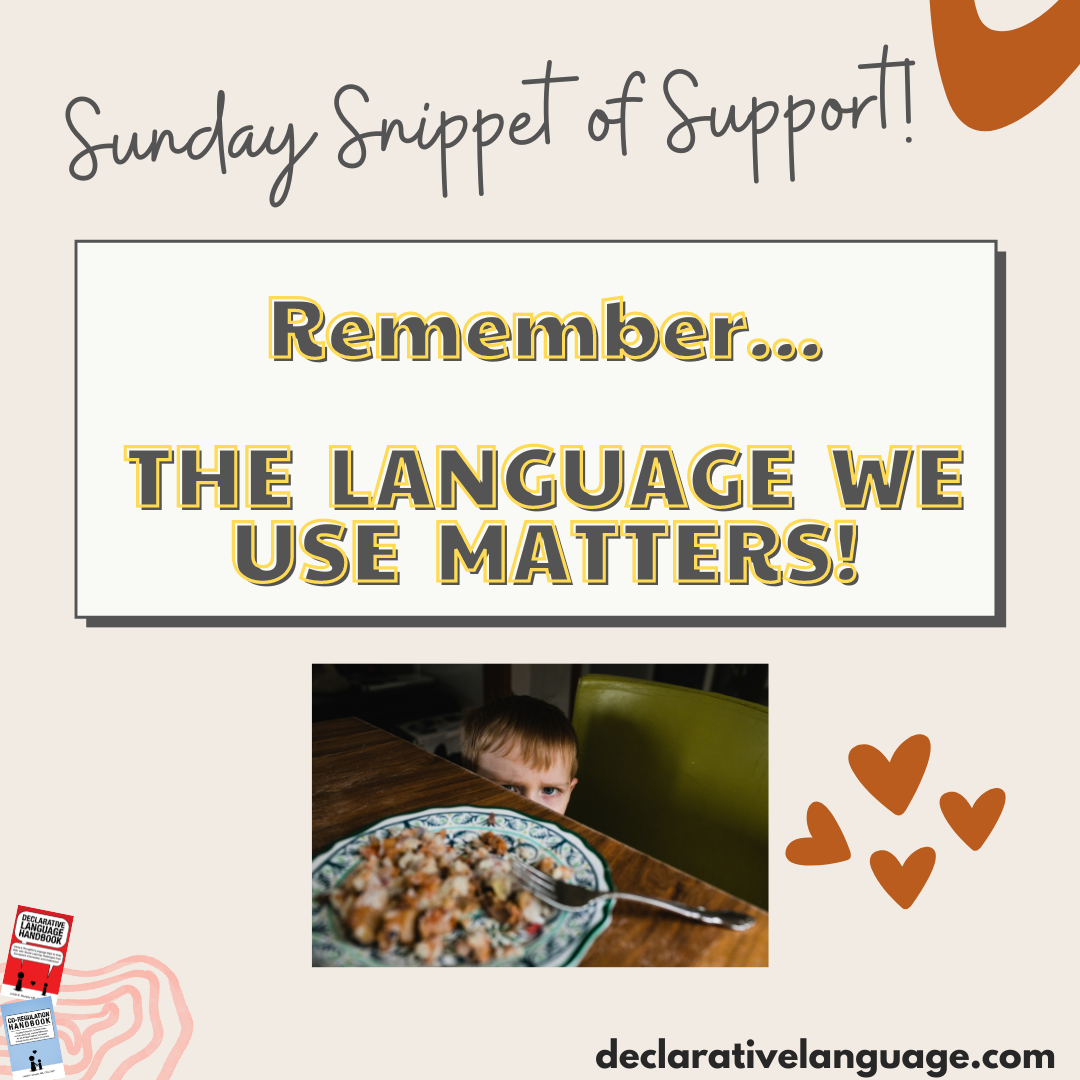Mealtime: The Language We Use Matters!
By Linda K. Murphy, Sarah Birdsall and Phoebe Russell
With the help of Meg Proctor (Two Sides of the Spectrum Podcast), Naureen Hunani, and Laura Hellfeld, we have been learning a lot lately about affirming practices when it comes to picky eating. Thank you to each of these professionals for sharing your conversations, wisdom, and lived experiences with us.
Hence, what initially was meant to be a guest post where I completely handed this space over to two of my skilled SLP colleagues, Sarah Birdsall and Phoebe Russell, has evolved into a collaboration, as we have reflected together more deeply on feeding therapy, and how mealtime and declarative language fit together. What we may have chosen to share a month ago, is different from what we are choosing to spotlight today!
I love how our field continues to provide us new information, new perspectives to think about, and creates space for different voices to be heard. I always find myself changing and growing, and wanting to do better, each day. Perhaps this post will help you shift your thinking on feeding therapy and mealtime as well, or at the least, give you more to consider as you approach mealtime with your “picky eaters”.
Thank you for being here!
If you have a selective, or “picky”, eater in your family - you are not alone! Every child’s feeding journey is different, and for many children, trying new and unfamiliar foods can be a challenge. However when introducing new or non-preferred food* to your child, using a positive, supportive, and understanding approach, with the help of declarative language, can make a big difference in how we all think about and enter mealtime.
In this post, we want to explore the power of our language when engaging kids in mealtime opportunities where they feel less sure, less confident, less comfortable, and perhaps even worried or scared. Our goal in supporting kids at mealtime is always to increase their joy of mealtime, strengthen their sense of self-agency, and increase their confidence around new foods, at a pace that feels comfortable and safe to them.
*Note on the term “non-preferred”: when something seems “non-preferred” to a child, there is usually a reason. Often, it may revolve around feelings of competence. Food and varying food items are no different! For example, a texture may be hard for a child to manage or feel uncomfortable in their mouth, or a flavor may be overwhelming to their sensory system.
It is always worth it to try and understand the connection between what we may perceive as “non-preferred” and what may come down to skill development. Yes, sometimes kids really don’t prefer an activity, task or food item. But, it is important to tease out when fear of the unknown, and/or not feeling competent, is the main obstacle holding someone back from trying something new. Because, when we frame opportunities through this lens of competence and skill development, and this includes mealtime opportunities, we are in a much better position to connect with the child, support them in a meaningful way, read their cues accurately, and find a flow, balance and pace that feels just right for them.
As with most things, when we introduce challenge at a place and pace that is just right for our learners, growth happens. But, we have to meet kids where they are right now, in each moment, and guide them with care and sensitivity, at a pace that honors what they want and feel ready for, as well.
Is it a picky eater, feeding disorder, or selective eating?
Whether or not you think your child has a Pediatric Feeding Disorder, ARFID (Avoidant Restrictive Food Intake Disorder), or is just selective, we always encourage parents and caregivers to reach for support if you have questions or concerns about your child’s feeding and mealtime experience. We are here to help you read your child’s cues, and subsequently better understand their mealtime patterns.
Mealtime Language and Why It’s Important
Using declarative language is always important; however, using it to help create positive mealtime experiences and/or positive memories around food, with children who are experiencing fear, worry or displeasure around food, can make all the difference.
In contrast, using imperative language such as demands, commands, questions, or negative instruction, can actually increase food related “worries” and make your child less willing or comfortable to try a new food.
Although it may feel natural to you to present a new food to your child and say “Take a bite” or “Can you try this?”, this can create pressure and increase stress for the child.
Instead, you can use declarative language to invite your child to explore a food item in a way that feels comfortable to them, which may not include taking a bite right away. That’s ok! There are actually thirty two steps working up to chewing and swallowing a food. You can trust your child to know when their body is ready to move to the next step. And, as you model and validate that they can trust their body and internal cues (interoception), they will come to develop greater self-awareness and ability to self-advocate when in a situation that doesn't feel good to them. These are life skills of utmost importance, across all contexts and facets of learning.
To follow are some examples of inviting language to use at mealtime, or when simply exploring new food.
Inviting language means you are modeling an idea that may be of interest to the child, but ultimately it is up to them if they join, simply observe, or even say “no”.
Gentle encouragement around a new or less familiar food item, when your child seems open or curious about it.
“We can open the yogurt together. You can hold the cup, and I will peel off the top.” (Including yourself in food exploratory tasks can allow your child to feel more comfortable when interacting with unfamiliar foods.)
“I’m wondering if you might like to open the applesauce and I can dump it into the bowl with our spoon.”
“It’s your choice! You could try a piece of bagel or waffle, if you’d like.”
Commenting to help describe actions with food, or the various elements of a food item, to increase confidence in, and understanding of, the unknown.
“You are touching the watermelon (i.e., any other action being performed). I bet it is squishy!”
“You have a huge piece of watermelon! I think that means you like it.”
“I am thinking we might need a knife to cut the apple, it looks like it’s hard!”
Using our Episodic memory. As you thoughtfully introduce new food items because you think your child may be interested in them, describe the connection between the new food, and their past positive experiences of similar but different food items, so they can perceive this connection as well. Offering foods that are similar in texture, flavor or appearance is a tool called “food chaining” that can help gently introduce new foods!
“I was thinking you might be curious about this pudding because it is a similar texture to yogurt, which I remember you like. But it is a little different too.”
“I remember you enjoy food that is soft and breaded on the outside, like chicken nuggets! These fish sticks are also soft and breaded on the outside. Maybe you’d like to check them out.”
Describing your own experiences of the food you are exploring together, while honoring that you each may have different feelings or opinions. These types of comments can also serve as language models for self-advocacy for your child.
“I am really excited to smell the pasta and see how it looks! I wonder if you are too.”
“I notice that the watermelon has a hard outside but a soft inside. It looks really juicy! I love when it’s extra juicy, but I don’t always like when my hands get wet!”
You can also discuss flavors (sweet, spicy, salty, bland, rich, sour), texture (bumpy, smooth, wet, dry, juicy), colors, smells, temperature and shapes:
“Those peppers are too spicy for my mouth! But I can tell that you like them. We’re different that way!”
“Bagels are hard work for my mouth because they are so chewy! Sometimes my jaw gets tired.”
Honor Autonomy. Remember, when a child says “no!” to a food presented, it is RARELY behavioral. There is a reason behind their refusal and it is our job as clinicians and caregivers to respect their autonomy and help cultivate a positive mealtime experience by allowing intrinsic motivation (i.e., hunger, social connection) to be the guide. Language that can help foster an affirming approach to feeding can also include acknowledging your child’s responses (verbal or nonverbal) to food using declarative language.
“I hear you and I see you when you push away the pretzel and say no. That’s okay, pretzels are really salty and crunchy and I appreciate you sharing with me that your mouth and body are not ready to explore them.”
“I see that you are turning your body away from the apple slice, and that shows me that your body is not ready to explore them yet, and that is okay! Apple slices can be really cold and crunchy, and I understand that cold, crunchy foods can feel really different when we explore them with our hands and mouth.”
It is important to understand that mealtime looks different for every child. What feels comfortable for one child may not feel comfortable for your child. Using language that complements an affirming approach to feeding will allow your child the ability to maintain trust and gain confidence.
We want your child to feel safe during mealtimes and cultivate positive mealtime experiences. Demands during mealtime, in the form of imperative language, increase stress, can trigger fight/flight/freeze reactions, and create a negative mealtime experience for all. Reading your child’s in-the-moment cues, and using declarative language to invite, comment, describe, share episodic memories, and model autonomy during food preparation and mealtimes can lay the groundwork for positive mealtime experiences.
Furthermore, using this type of connecting language can help kids feel safe to go outside their comfort zone as they are ready, and ultimately, help them develop important life skills such as self-awareness, self-advocacy, and confidence around novelty.
Have a great week!
If you like my Sunday Snippets of Support, you can receive them directly to your inbox here.






